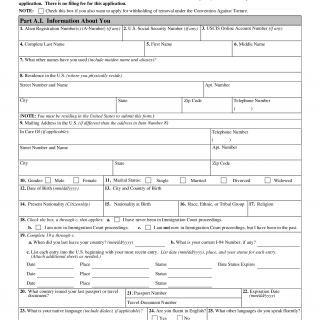Form I-589. Application for Asylum and for Withholding of Removal
The I-589, Application for Asylum and for Withholding of Removal, is a form used by individuals who are seeking asylum or withholding of removal in the United States. The main purpose of the form is to allow individuals to apply for protection from persecution or harm in their home country.
The I-589 consists of several parts, including personal information, information about the applicant's background and history, and a detailed statement of the applicant's claim for asylum or withholding of removal. The form also requires the applicant to provide supporting documents, such as birth certificates, passports, and any other relevant identification or documentation.
When writing an I-589, it is important to consider the parties involved, such as the applicant and the United States Citizenship and Immigration Services (USCIS). The applicant will need to provide accurate and detailed information about their background and history, as well as a compelling claim for asylum or withholding of removal. USCIS will review the application and supporting documents to determine whether the applicant qualifies for protection.
To complete an I-589, the applicant will need to provide personal information, including their name, date of birth, and country of origin. They will also need to provide detailed information about their background and history, including any persecution or harm they have experienced or fear they will experience if they return to their home country. Supporting documents that may need to be attached include birth certificates, passports, and any other relevant identification or documentation.
The I-589 is an important form for individuals who are seeking protection in the United States. It is used by individuals who have fled their home country due to persecution or harm and who fear returning. The form is intended to provide a pathway to protection for those who qualify.
Strengths of using an I-589 include the ability to seek protection from persecution or harm in one's home country, as well as the ability to remain in the United States while the application is being processed. Weaknesses include the potential for a lengthy and complex application process, as well as the potential for denial of the application.
Alternative forms to an I-589 include the I-730, Refugee/Asylee Relative Petition, which is used by individuals who have been granted asylum or refugee status to petition for family members to join them in the United States.
In terms of future implications, the I-589 can have significant legal and personal consequences for the applicant. If approved, the applicant may be granted protection in the United States and may be able to remain in the country. If denied, the applicant may be required to return to their home country.
The I-589 can be submitted to USCIS either by mail or in person at a USCIS office. It is important to keep a copy of the application and supporting documents for future reference.

